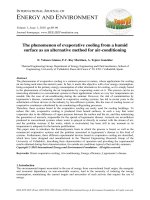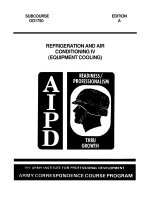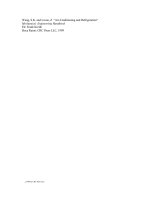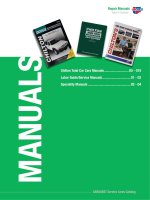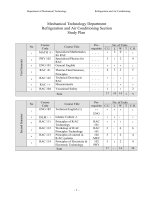Camry Repair Manual Air conditioning
Bạn đang xem bản rút gọn của tài liệu. Xem và tải ngay bản đầy đủ của tài liệu tại đây (2.33 MB, 56 trang )
AIR CONDITIONING SYSTEM
–AIR CONDITIONING SYSTEM
AC–1
GENERAL INFORMATION
1. WHEN HANDLING REFRIGERANT (R–12),
FOLLOWING PRECAUTIONS MUST BE OBSERVED.
(a) Do not handle refrigerant in an enclosed area or near
an open flame.
(b) Always wear eye protection.
(e) Be careful that liquid refrigerant does not get in your
eyes or on your skin.
If liquid refrigerant gets in your eyes on your skin;
• Do not rub.
• Wash the area with a lot of cool water
• Apply clean petroleum jelly to the skin.
• Go immediately to a physician or hospital for
professional treatment.
• Do not attempt to treat yourself.
(d) Discharge refrigerant from the charging valve before
installing the new compressor.
If the refrigerant is not discharged first, compressor oil will
spray out with the refrigerant gas when the plug is r
moved.
(e) Do not use a burner for bending or lengthening opera-
tions on tubes.
If tubes are heated with a burner, a layer of oxidation forms
inside the tube, causing the same kind of trouble as an ac–
cumulation of dust.
3. WHEN TIGHTENING CONNECTING PARTS;
(a) Apply a few drops of compressor oil to O–ring fittings
for easy tightening and to prevent leaking of refriger-
ant gas.
(b) Tighten the nut using two wrenches to avoid twisting
the tube.
2. WHEN REPLACEiNG PARTS ON REFRIGERANT LINE;
(a) Discharge refrigerant slowly before replacement.
(b) Insert a plug immediately in disconnected parts to
prevent entry of moisture and dust.
(c) Do not leave a new condenser or receiver, etc., lying
around with the plug removed.
–AIR CONDITIONING SYSTEM General Information
AC–2
(e) Tighten the O–ring fittings or the bolted type fittings to
the specified torque.
4. WHEN CONNECTING MANIFOLD GAUGE;
(a) Be sure to connect the charging hose end with a pin
to the compressor charging valve.
(b) The letter ”D” engraved near the compressor service
valve indicates the high pressure side, and ”S” indi-
cates the low pressure side. Pay careful attention
when connecting the hose.
(c) Tighten hose by hand.
(d) To prevent loosening of connected hose, do not apply
drops of compressor oil to the seat of connection.
HINT: After connecting the manifold gauge and the refrig–
erant container (service can), discharge any air in the
hoses.
5. WHEN EVACUATING;
Approx. 15 minutes after removal, check the system for
leaks, then take at least another 15 minutes to make sure
the air is fully removed.
6. WHEN HANDLING REFRIGERANT CONTAINER
(SERVICE CAN);
(a) Must never be heated.
(b) Must be kept below 4
W°C (1 04°F).
(c) If warming service can with hot water, be careful that
the valve on top of the service can is never immersed
in the water, as the water may permeate into the refrig-
erant cycle.
(d) Empty service cans must never be re–used.
7. WHEN A/C IS ON AND REFRIGERANT GAS IS
BEING REPLENISHED;
(a) If there is not enough refrigerant gas in the refrigerant
cycle, oil lubrication becomes insufficient and com-
pressor burnout may occur, so take care to avoid this.
(b) If the valve on the high pressure side is opened, refrig-
erant flows in reverse and causes the service can to
rupture, so only open and close the vlave on the low
pressure side.
(c) If the service can is inverted and refrigerant is inserted
in a liquid state, the liquid is compressed and the com-
pressor brakes down, so the refrigerant must be in-
serted in a g¿¿seous state.
(d) Be careful not to insert too much refrigerant gas, as
this causes trouble such as inadequate cooling, poor
fuel economy, engine overheat, etc.
8. WHEN USING GAS–CYLINDER TYPE LEAK
DETECTION INSTRUMENT;
(a) As a naked flame is used, first make sure that there are
no flammable substances nearby before using it.
(b) Be careful, as poisonous gas is produced when
refrigerant gas comes in contact with heat parts.
–AIR CONDITIONING SYSTEM Genera! Information
AC–3
AIR CONDITIONING SYSTEM CIRCUIT
(Lever Type on 3S–FE Engine FWD Model)
–AIR CONDITIONING SYSTEM Air Conditioning System Circuit
AC–4
(Push Type on 3S–FE Engine FWD Model)
–AIR CONDITIONING SYSTEM Air Conditioning System Circuit
AC–5
(Lever Type on 3S–FE Engine All–Trac/4WD Model)
–AIR CONDITIONING SYSTEM Air Conditioning System Circuit
AC–6
(Push Type on 3S–FE Engine All–Trac/4WD Model)
–AIR CONDITIONING SYSTEM Air Conditioning System Circuit
AC–7
(Lever Type on 2VZ–FE Engine Model)
–AIR CONDITIONING SYSTEM Air Conditioning System Circuit
AC–8
–AIR CONDITIONING SYSTEM Air Conditioning System Circuit
AC–9
(Push Type on 2VZ–FE Engine Model)
–AIR CONDITIONING SYSTEM Air Conditioning System Circuit
AC–10
–AIR CONDITIONING SYSTEM Air Conditioning System Circuit
AC–11
SYSTEM COMPONENTS
–AIR CONDITIONING SYSTEM System Components
AC–12
4. The liquid refrigerant is charged by the expansion valve into a low temperature, low pressure liquid and
geseous mixture.
5. This cold and foggy refrigerant flows to the evaporator. Vaporizing the liquid in the evaporator, the heat
from the warm air stream passing through the evaporator core is transfered to the refrigerant.
All the liquid is changed into geseous refrigerant in the evaporator and only heat–laden geseous refrig-
erant is drawn into the compressor. Then the process is repeated again.
GENERAL DESCRIPTION
REFRIGERATION CYCLE
1. The compressor discharges high temperature and high pres-
sure refrigerant containing the heat absorbed from the
evaporator plus the heat created by the compressor in a dis-
charge stroke.
2. This gaseous refrigerant flows into the condenser. In the con-
denser, the gaseous refrigerant condenses into liquid
refrigerant.
3. This liquid refrigerant flows into the receiver which stores and
filters the liquid refrigerant till the evaporator requires the ref–
rigerant.
–AIR CONDITIONING SYSTEM AIR CONDITIONING SYSTEM General Description
AC–13
Ignition Switch ”ON”
Blower Switch ”’ON” → Heater Relay “ON” (Blower Motor ”RUN”)
A/C Switch ”ON” → A/C Amplifier ”’ON” (A/C Amp. Main Power Supply)
1. PRINCIPLE OF A/C ELECTRICAL CIRCUIT
2. HOW IS MAGNETIC CLUTCH ENERGIZED?
The general process until the magnetic clutch is energized is shown below.
Dual Pressure Switch ”’ON”:
Refrigerant Condition (2.1 kg/cm2 (30 psi, 206 kPa) less than 27 kg/cm
2
(384 psi, 2,648 kPa))
Thermistor supplies temperature signal of evaporator to A/C amplifier.
VSV ”ON” → E/G Idle–Up
Magnetic Clutch Relay ”’ON”
Temperature Sensor ”ON”:
Temperature of Temperature Sensor is less than 180
°C (356°F).
Magnetic Clutch ”ON”
Revolution Detecting Sensor supplies RPM signal of compressor to A/C amplifier.
If compressor is not locked, magnetic clutch is continuously energized.
–AIR CONDITIONING SYSTEM General Description
AC–14
To evacuate and charge system
To perform electrical diagnosis
To perform electrical diagnosis
To perform electrical diagnosis
To remove and install pressure plate
To remove pressure plate
To remove and install rotor and stator
Air conditioner service tool set
Ohmmeter
Voltage meter
Ammeter
Magnetic clutch stopper
Magnetic clutch remover
Snap ring pliers (External type)
SPECIAL TOOLS AND EQUIPMENT
SSM (SPECIAL SERVICE MATERIALS)
07110–58011
07112–76060
07112–66040
07114–84020
DENSOOIL 6,
SUNlSO No. 5GS or equivalent
07117–68040
Compressor
Part Name
SST No.
Part No.
Use etc.
Tool
Use
–AIR CONDITIONING SYSTEM Special Tools and Equipment
AC–15
To evacuate and charge system
To perform electrical diagnosis
To perform electrical diagnosis
To perform electrical diagnosis
To remove and install pressure plate
To remove pressure plate
To remove and install rotor and stator
Air conditioner service tool set
Ohmmeter
Voltage meter
Ammeter
Magnetic clutch stopper
Magnetic clutch remover
Snap ring pliers (External type)
SPECIAL TOOLS AND
EQUIPMENT
SSM (SPECIAL SERVICE MATERIALS)
07110–58011
07112–76060
07112–66040
07114–84020
DENSOOIL 6,
SUNlSO No. 5GS or equivalent
07117–68040
Compressor
Part Name
SST No.
Part No.
Use etc.
Tool
Use
–AIR CONDITIONING SYSTEM SST (Special Service Materials)
AC–15
Blower does not, operate
(a) GAUGE fuse blown
(b) FL blown
(c) Circuit breaker faulty
(d) HEATER relay faulty
(e) HEATER fuse blown
(f) Blower motor faulty
(g) Blower resistor faulty
(h) Blower switch faulty
(i) Wiring or ground faulty
Magnetic clutch does not engage
(a) FL (30A CDS) blown
(b) Magnetic clutch relay faulty
(c) Magnetic clutch faulty
(d) A/C fuse faulty
(e) A/C switch faulty
(f) Thermistor faulty
(g) A/C amplifier faulty
(h) Revolution detecting sensor faulty
(i) Pressure switch faulty
(j) Wiring or ground faulty
(k) Refrigerant empty
Compressor does not rotate properly
(a) Drive belt loose or broken
(b) Compressor faulty
Expansion valve faulty
Leak i n system
Replace FL and check for short
Check relay
Check magnetic clutch
Replace fuse and check for short
Check switch
Check thermistor
Check amplifier
Check sensor
Check switch
Repair as necessary
Check refrigerant pressure
Replace fuse and check for short
Replace FL and check for short
Check circuit breaker
Check relay .
Replace fuse and check for short
Check blower motor
Check blower resistor
Check blower switch
Repair as necessary
Magnetic clutch slipping
Expansion valve faulty
Excessive moisture in the system
Revolution detecting sensor faulty
A/C amplifier faulty
Wiring connection faulty
Condenser clogged
Drive belt slipping
Compressor faulty
Insufficient or too much refrigerant
Air i n system
Check magnetic clutch
Check expansion valve
Evacuate and charge system
Check sensor
Check amplifier
Repair as necessary
Check condenser
Check or replace drive belt
Check compressor
Check refrigerant volume
Evacuate and charge system
AC–4 to 11
AC–37
AC–23
AC–4 to 11
AC–44
AC–43
AC–45 to 47
AC–24
AC–36
AC–4 to 11
AC–18, 22
Ajust or replace drive belt
Check compressor
Check expansion valve
Test system for leaks
TROUBLESHOOTING
AC–4 to 11
AC–4 to 11
AC–4 to 11
BE–73
AC–4 to 11
Cool air comes out
only at high speed
AC–24
AC–45 to 47
AC–4 to 11
Coo! air comes
out intermittently
BE–73
BE–72, 74
AC–4 to 11
AC–33
AC–21
AC–23
AC–22
AC–21
AC–23
AC–39
AC–42
* FL: Fusible Link
Possible cause
AC–23
AC–39
No cooling
Remedy
Problem
Page
–AIR CONDITIONING SYSTEM Troubleshooting
AC–16
Discharging of Refrigeration System
Evacuating and Charging of
Refrigeration System
(See Air Conditioning Fundamentals and Repairs Pub. No.
36950E)
Condenser clogged
Drive belt slipping
Magnetic clutch faulty
Compressor faulty
Expansion valve faulty
Thermistor faulty
A/C amplifier faulty
Insufficient or too much refrigerant
Air or excessive compressor oil in
system
Receiver clogged
Water valve cable set faulty
Check condenser .
Check or replace drive belt
Check magnetic clutch
Check compressor
Check expansion valve
Check thermistor
Check amplifier
Check refrigerant volume
Evacuate and charge system
Evaporator clogged or frosted
Air leakage from cooling unit or air duct
Air inlet blocked
Blower motor faulty
A/C amplifier faulty
Drive belt slipping
Revolution detecting sensor faulty
(w/Power steering)
A/C amplifier faulty
AC–33
AC–21
AC–23
AC–23
AC–39
AC–43
AC–45 to 47
AC–22
Repair as necessary
Replace blower motor
Check amplifier
Clean evaporator fins or filters
Repair as necessary
Check or replace drive belt
Check sensor
Check receiver
Reset water valve cable
A/C switch
indicator
flashing
Insufficient
velocity of cool
air
AC–41
AC–39 to 42
Insufficient
cooling
Check amplifier
Possible cause
AC–21
AC–24
AC–32
BE–79
AC–39 to 42
AC–45 to 47
AC–45 to 47
Remedy
Problem Page
–AIR CONDITIONING SYSTEM Troubleshooting Refrigeration System
AC–17
Checking of Refrigeration System with Manifold Gauge
This is a method in which the trouble is located by using a manifold gauge. Read the manifold gauge
pressure when the following conditions are established:
(a) Temperature at the air inlet is 30 – 35
°C (86 – 95°F)
(b) Engine running at 1,500 rpm
(e) Blower fan speed switch set at high speed
(d) Temperature control lever set at cool side
HINT: It should be noted that the gauge indications may vary slightly due to ambient temperature condi–
tions.
NORMALLY FUNCTIONING
REFRIGERATION SYSTEM
Gauge reading:
Low pressure side
1.5 – 2.0 kg/cm
2
(21 – 28 psi, 147 – 196 kPa)
High pressure side
14.5 – 15.0 kg /cm
2
(206 – 213 psi, 1,422–1,471 kPa
Each pointer of manifold gauge
point to position A
Expansion valve improperly mounted, heat
sensing tube defective (opens too wide)
Does not coo! (cools from time to time in
some cases)
Refrigerant overcharge or insufficient
cooling of condenser
Moisture present in refrigeration system
Periodically cools and then fails to cool
Air present in refrigeration system
Poor circulation of refrigerant
Refrigerant does not circulate
Does not cool sufficiently
Does not cool sufficiently
Insufficient compression
Insufficient refrigerant
Position of Pointers
Insufficient cooling
Insufficient cooling
Insufficient cooling
Low is D
High is O
Between A and B
Does not cool
ConditionTrouble
–AIR CONDITIONING SYSTEM Troubleshooting
AC–18
*NOTE at No.6
These gauge indications are shown when the refrigeration system has been opened and the re-
frigerant charged without vacuum purging.
(1)Clean condenser
(2)Check fan motor operation
(3)If (1) and (2) are normal,
check refrigerant amount
HINT: Vent out refrigerant
through gauge manifold low
pressure side by gradually
opening valve.
(1)Replace receiver and drier
(2)Check compressor oil to
see if dirty or insufficient
(3)Vacuum purge and charge
new refrigerant
Drier in oversaturated state
Moisture in refrigeration
system freezes at expansion
valve orifice and blocks
circulation of refrigerant
(1)Replace receiver and
drier
(2)Remove moisture in cycle
through repeated vacuum
purging
(3)Charge refrigerant to proper
amount
Excess refrigerant in cycle –
refrigerant overcharged
Condenser cooling
insufficient – condenser fins
clogged or fan motor faulty
Unable to develop
–sufficient performance due to
excessive refrigerant in system
Condenser cooling insufficient
Moisture entered in
refrigeration system freeze
at expansion valve orifice
and temporarily stops
cycle, but normal state is
restored after a time when the
ice melts
Pressure too high at both low
and high pressure sides
Frost or large amount of dew
on piping at low pressure side
(1)Check heat sensing
tube installed condition
(2)If (1) is normal, test
expansion valve in unit
(3) Replace if defective
Pressure low at both low and
high pressure sides
Bubbles seen in sight glass
Insufficient cooling
performance
Air present in refrigeration
system
Insufficient vacuum
purging
During operation, pressure at
low pressure side sometimes
becomes a vacuum and
sometimes normal
Trouble in expansion valve
or heat sensing tube not
installed correctly
Refrigerant flow out
Pressure low at both low and
high pressure sides
Frost on tubes from
receiver to unit
(1)Check with leak tester
and repair
(2)Charge refrigerant to
proper amount
Excess refrigerant in low
pressure piping
Expansion valve opened too
wide
Insufficient refrigerant in
system
Refrigerant leaking
Pressure too high at both low
and high pressure sides
Pressure too high at both
tow and high pressure sides
Gas leakage at some place i n
refrigeration system
Refrigerant flow
obstructed by dirt in
receiver
Air entered refrigeration
system
Symptom seen in
refrigeration system
Receiver clogged Replace receiver
Probable cause
Diagnosis
Remedy
No.
–AIR CONDITIONING SYSTEM Troubleshooting
AC–19
Allow to stand for some time
and then restart operation to
determine if trouble is
caused by moisture or dirt.
If caused by moisture refer to
procedures¿Step 2 on
,page AC–19.
If caused by dirt, remove
expansion valve and clean off
dirt by blowing with air. If
unable to remove dirt, replace
valve.
Vacuum purge and charge
new refrigerant to proper
amount.
For gas leakage from heat
sensing tube, replace
expansion valve.
Refrigerant flow obstructed by
moisture or dirt in refrigerant
freezing or adhering to
expansion valve orifice
Refrigerant flow obstructed by
gas leakage from expansion
valve heat sensing tube
Internal leak in compressor
Vacuum indicated at low
pressure side, very low
pressure indicated at high
pressure side
Pressure too high at low
pressure side
Pressure too low at high
pressure side
Frost or dew seen on
piping before and after
receiver and drier or
expansion valve
Repair or replace compressor
Symptom seen in
refrigeration system
Probable cause
Diagnosis
Remedy
No.
Expansion valve orifice
clogged
Refrigerant does not
flow
Compression defective
Valve leaking or broken
sliding parts (Piston, cylinder,
gasket, etc. broken
–AIR CONDITIONING SYSTEM Troubleshooting
AC–20
HINT:
• ”New belt” refer to a belt which has been used less
than
5 minutes on a running engine.
• ”Used belt” refer to a belt which has been used on a
running engine for 5 minutes or more.
• After installing the drive belt, check that it fits properly
i n the ribbed grooves.
4. START ENGINE
5. TURN ON A/C SWITCH
Check that the A/C operates at each position of the blower
switch.
6. CHECK MAGNETIC CLUTCH OPERATION
If magnetic clutch does not engage, check the A/C fuse.
7. CHECK THAT IDLE INCREASES
When the magnetic clutch engages, engine revolution
should increase.
Standard idle–up rpm:
ON–VEHICLE INSPECTION
1. CHECK CONDENSER FINS FOR BLOCKAGE OR
DAMAGE
If the fins are clogged, clean them with pressurized water.
NOTICE: Be careful not to damage the fins.
2. MAKE SURE THAT DRIVE BELT IS INSTALLED
CORRECTLY
Check that the drive belt tits properly in the ribbed
grooves.
3. CHECK DRIVE BELT TENSION
Using a belt tension gauge, check the drive belt tension.
Belt tension gauge:
Nippondenso BTG–20 (95506–00020) or
Borroughs No. BT–33–73F
Drive belt tension
Standard idle–up rpm:
Used Belt
New Belt
Engine
Engine
2¿¿–FE
2VZ–FE
3S–FE
3S–FE
–AIR CONDITIONING SYSTEM On–vehicle Inspection
AC–21
8. CHECK CONDENSER FAN MOTOR ROTATES
9. CHECK AMOUNT OF REFRIGERANT
If you can see bubbles in the sight glass, additional refrig-
erant is needed.
(See page AC–22)
10. IF NO COOLING OR IT IS INSUFFICIENT, INSPECT
FOR LEAKAGE
Using a gas leak tester, inspect each component of the re-
frigeration system.
REFRIGERATION SYSTEM
Checking of Refrigerant Volume
1. RUN ENGINE AT APPROX. 1,500 RPM
2. OPERATE AIR CONDITIONER AT MAXIMUM
COOLING FOR A FEW MINUTES
3. CHECK AMOUNT OF REFRIGERANT
Observe the sight glass on the receiver.
Immediately after the air conditioner is
turned off, refrigerant in sight glass stays
clear
When the air conditioner is turned off,
refrigerant foams and then stays clear
Evacuate and charge system.
Then check for leak with gas leak
detector
Temperature between compressor inlet
and outlet is noticeably different
Discharge the excess refrigerant to
specified amount
No temperature difference between
compressor inlet and outlet
Check for leak with gas leak
tester
No bubbles present in sight glass
Bubbles present in sight glass
Empty, proper or too much
Empty, proper or too much
Amount of refrigerant
Empty or nearly empty
Refer to items 5 and 6
Refer to items 3 and 4
Refer to items 3 and 4
Proper or too much
Insufficient
Symptom
Too much
Remedy.
Item
–AIR CONDITIONING SYSTEM On–Vehicle Inspection
AC–22
8. CHECK CONDENSER FAN MOTOR ROTATES
9. CHECK AMOUNT OF REFRIGERANT
If you can see bubbles in the sight glass, additional refrig-
erant is needed.
(See page AC–22)
10. IF NO COOLING OR IT IS INSUFFICIENT, INSPECT
FOR LEAKAGE
Using a gas leak tester, inspect each component of the re-
frigeration system.
REFRIGERATION SYSTEM
Checking of Refrigerant Volume
1. RUN ENGINE AT APPROX. 1,500 RPM
2. OPERATE AIR CONDITIONER AT MAXIMUM
COOLING FOR A FEW MINUTES
3. CHECK AMOUNT OF REFRIGERANT
Observe the sight glass on the receiver.
Immediately after the air conditioner is
turned off, refrigerant in sight glass stays
clear
When the air conditioner is turned off,
refrigerant foams and then stays clear
Evacuate and charge system.
Then check for leak with gas leak
detector
Temperature between compressor inlet
and outlet is noticeably different
Discharge the excess refrigerant to
specified amount
No temperature difference between
compressor inlet and outlet
Check for leak with gas leak
tester
No bubbles present in sight glass
Bubbles present in sight glass
Empty, proper or too much
Empty, proper or too much
Amount of refrigerant
Empty or nearly empty
Refer to items 5 and 6
Refer to items 3 and 4
Refer to items 3 and 4
Proper or too much
Insufficient
Symptom
Too much
Remedy.
Item
–AIR CONDITIONING SYSTEM Refrigeration System
AC–22
COMPRESSOR
ON–VEHICLE INSPECTION
1. INSTALL MANIFOLD GAUGE SET
(See page AC–23)
2. RUN ENGINE AT APPROX. 1,500 RPM
3. CHECK COMPRESSOR FOR FOLLOWING:
(1) High pressure gauge reading is not lower and low
pressure gauge reading is not higher than normal.
(b) Metallic sound
(e) Leakage from shaft seal
If defects are found, repair the compressor.
4. CHECK MAGNETIC CLUTCH
(a) Inspect the pressure plate, and the rotor for signs of
oil.
(b) Check the clutch bearings for noise and grease leak-
age.
(e) Using an ohmmeter, measure the resistance of the
stator coil between the clutch lead wire and ground.
Standard resistance: 3.4 – 3.8
W at 20°C (68°F)
If resistance value is not as specified, replace the coil.
(d) Connect the positive (+) lead from the battery to ter-
minal 1, check that the magnetic clutch is energized.
If magnetic clutch is not energized, replace the coil.
NOTICE: Do not short positive (+) lead wire on the vehicle
by applying battery voltage.
Installation of Manifold Gauge Set
1. CLOSE BOTH HAND VALVES OF MANIFOLD GAUGE
SET
2. INSTALL CHARGING HOSES OF GAUGE SET TO
CHARGING VALVES
Connect the low pressure hose to the low pressure charg-
ing valve and the high pressure hose to the high pres-
sure charging valve. Tighten the hose nuts by hand.
HINT Do not apply compressor oil to the seat of the con-
nection.
–AIR CONDITIONING SYSTEM Refrigeration System
AC–23
